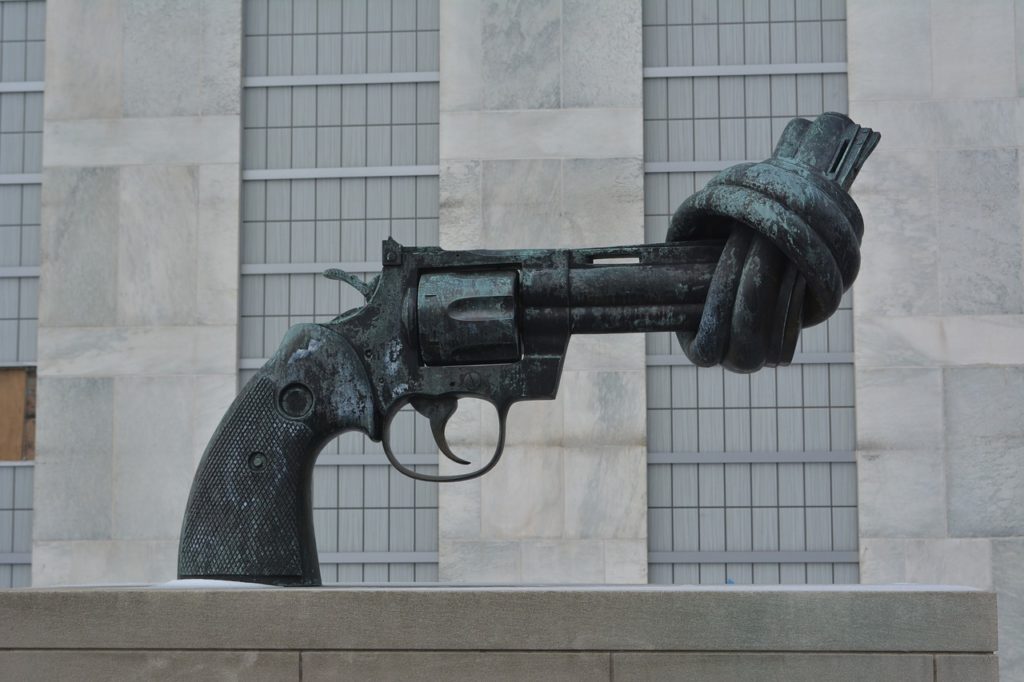NEW YORK – The United Nations General Assembly declared the second day of October as the International Day of Non-Violence. It has been observed annually since 2007, yet its true meaning becomes less clear the more one studies the thought-leaders who address the subject.
What Non-Violence Is Not
 In far too many thousands of cities and homes, a sobbing woman or child might personify non-violence as they plead to their abuser, “Please . . . don’t hit me again.” That sounds like the type of thing Christians should rally around – and we do.
In far too many thousands of cities and homes, a sobbing woman or child might personify non-violence as they plead to their abuser, “Please . . . don’t hit me again.” That sounds like the type of thing Christians should rally around – and we do.
Take, for instance, Gospel for Asia (GFA World), a 41-year-old, faith-based organization working in South Asia. They have campaigned against domestic abuse and violence continually. In addition, they have published several special reports that raise awareness of those evils imposed upon the innocent. They include
- “Ending Violence Against Women” by Delia Acevedo
- “Defending Human Rights and Seeking Social Justice” by Palmer Holt
- The feature-length documentary film, “Veil of Tears.”
However, as pressing as the issue of violence is as we generally conceive of it, the UN, its affiliates, and humanitarian agencies speak of non-violence in terms of pressing political and social movements.
What Non-Violence Is
The UN variously defines non-violence as “non-violent resistance,” “a form of social struggle,” and “to undermine such power through withdrawal of the consent and cooperation of the populace.”
In fact, the UN espouses the definition of non-violence coined by Gene Sharp in his book, The Politics of Nonviolent Action, published in 1973. That work promoted “198 methods of non-violent action” that included protests, rude gestures, taunting officials, ostracism, social disobedience, withholding rent, fees, or debts, blacklisting, rejection of authority, and non-cooperation.
One prominent social justice website promotes non-violence as “passive resistance . . . and civil disobedience.” The site uses the 2014 “Umbrella Movement” in Hong Kong, although the more recent “Occupy” movement could equally represent a more closely-aligned characterization of the contemporary meaning of non-violence.
Christians Beware
What does become clearer when studying non-violence is that so-call non-violent actions inevitably lead, directly or indirectly, to acts of violence in one form or another.
The non-violence promoted by the International Day of Non-Violence is entirely outside of the scope of Christian love. Be careful, because the approach is as subtle as the serpent subverting God’s authority in the Garden of Eden.
One of the slyly hidden targets of the non-violence movement is “hate speech.” We need to be keenly aware that “hate speech” encompasses nearly anything written or spoken that is not tolerant of all other mindsets or behaviors. The day is fast approaching when reading Romans chapters one, three, six, or ten – or any other Scripture – might be labeled as hate speech.
The unregenerate mind is at enmity with God and His authority. We need to remember that, but we also need to evidence the same love that Jesus demonstrated for those who crucified Him. “Father, forgive them for they know not what they do.”
May the Lord give you all the wisdom to discern the difference between truth and error.
Read more news on the Eastern Europe and World Missions on Missions Box.
Sources:
- The United Nations, International Day of Non-Violence
- Youth in Front, Martin Luther King Jr.’s Six Principles of Nonviolence
- Humanium, October 2, International Day: The Power of Nonviolence!




